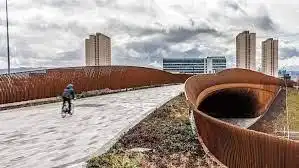As the demand for faster construction has led to an increasing demand for 3D printing in construction. Although still in its early stages, 3D printing has shown great promise in the building industry, with entire structures already being built more sustainably, with less labour and time. A 3D printer produces layers of concrete, plastic, and metal, one layer at a time to build a structure. The constructed part created using the additive manufacturing process produces a highly precise and customizable structure at a faster speed with less waste. 3D printing has been used to produce numerous incredible structures all over the world, including 3D printed houses, cabins, offices, bridges, pavilions, large-scale structures, shelters, and more In regard, to the adoption of 3d printing across the globe Glasgow has unveiled 3D-printed concrete marvel- new “active transport” bridge.
Glasgow’s stunning new “active transport” bridge is now open to the public, connecting over 800 new homes in the Sighthill area to the city centre. This innovative bridge is part of a £250 million regeneration project, which is the largest of its kind in the U.K. outside London. The 2,420-tonne structure was installed during a 14-hour closure of the M8 motorway in the summer of 2021. It was opened on 22nd March 2023.


3D-printed new active transport bridge in Scotland
The features of the project;
The project features the first use of 3D concrete printing in Scotland for the bridge’s staircase, making it the largest printed concrete construction in the UK. Clad in granite, the staircase offers an attractive, long-lasting, and slip-free finish. The bridge’s successful completion showcases the potential of cutting-edge digital techniques and collaboration in construction.
The use of 3D Concrete Printing
3D Concrete Printing has been used to manufacture different components of the bridge. BAM UK collaborated with Weber Bemix, a Netherlands-based concrete printing expert, to print the staircase components. The partnership between BAM and Weber Bemix has a history of successful projects, including the world’s longest 3D concrete printed bridge in Nijmegen, Netherlands, in 2021.
3D concrete printing offered numerous advantages, including creating intricate, unique components of the bridge that are difficult to achieve with traditional formwork. The strength of the 3D-printed staircase manufactured is equal to that of on-site poured concrete, and the controlled environment manufacturing eliminates weather concerns and reduces on-site construction risks. Automated sensors were also used to ensure the quality of the mortar during the printing process.
Ian Steele, BAM Contracts Manager for the M8 Footbridge, expressed his delight with the project’s outcome and the potential for 3D concrete printing to modernise construction, reduce risk, improve efficiency, and lower carbon footprints.

The main span of the new structure was installed during a 14-hour closure of the M8 motorway in summer 2021 with the 2420-tonne structure pirouetted into place by BAM and specialists, Mammoet. The bridge is manufactured using Cor-Ten steel for a weathered appearance, reducing maintenance costs and reflecting the area’s industrial heritage.
BAM became the first construction contractor in Scotland to make use of 3D concrete printing to create the staircase which will provide access on the south-side of the new structure.
BAM Contracts Manager Ian Steele said: ‘We’re so pleased to see the bridge open to the public. It’s the culmination of a lot of hard work from our construction team, Glasgow City Council and our subcontractor partners. I’m absolutely delighted with the look of the new structure – the views across Glasgow are fantastic and the structure itself looks glorious now that the landscaping is complete. The project has pushed the boundaries of what’s possible within construction, using cutting-edge digital techniques and collaboration from everyone involved. We are proud to leave a sustainable legacy that will benefit the North of Glasgow for years to come.’
Councillor Susan Aitken, Leader of Glasgow City Council and Chair of the Glasgow City Region City Deal, said: ‘The ongoing regeneration of Sighthill is one of the biggest projects of its kind on these islands – and the completion of this remarkable bridge is a real landmark in that journey. It signals the reconnection of Sighthill with not only the city center but also neighbouring communities in North Glasgow.’
Looking Ahead: The Future of 3D Concrete Printing in Construction
As 3D concrete printing technology continues to advance, its applications in construction are expected to grow. The successful completion of Glasgow’s active transport bridge demonstrates the potential for this technology to revolutionize the industry. Using 3D printing in construction projects can lead to more sustainable and efficient practices, reducing waste and carbon emissions while enabling greater design flexibility and customization.
As more contractors adopt this innovative technology, the construction industry in the U.K. can continue to evolve, providing sustainable and cutting-edge solutions for infrastructure projects worldwide.
Reference: bam.com, innovationorigins.com


